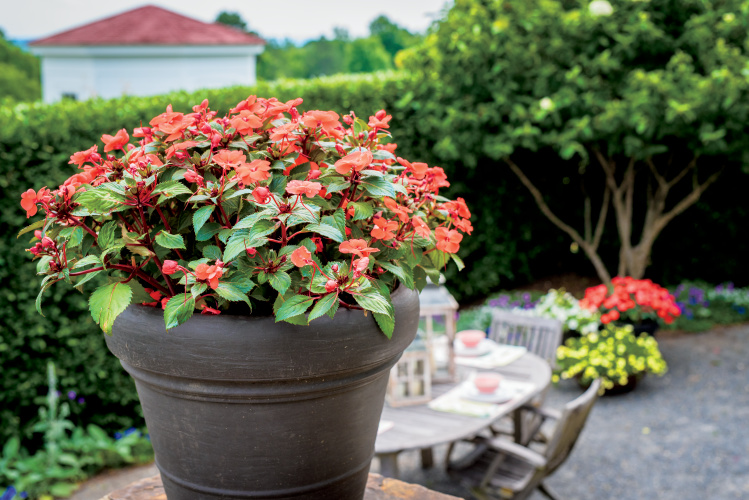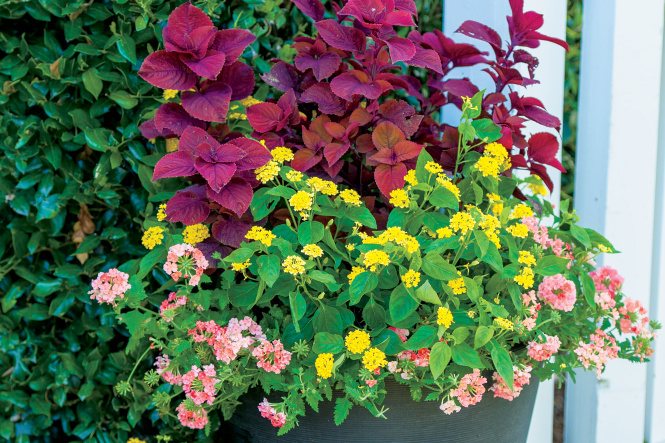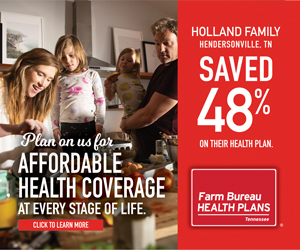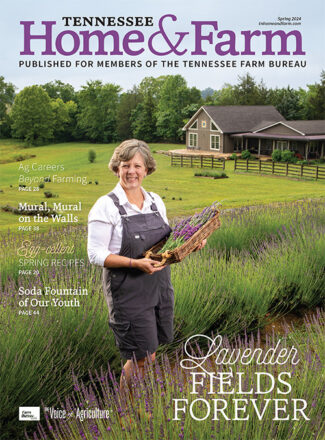Why Container Plants Are Perfect for Limited Space

When you visit Moss Mountain Farm, you’ll see that I have container plantings everywhere – on the porch, around the fountain, and even in the vegetable and flower gardens. They’re so versatile. Whether you have limited space or you’re trying to do something a little more creative around your garden, containers are the solution. Container gardens can provide pops of color and allow you to add more variety to your garden in spite of space limitations.
Before running off to the garden center, you need to consider five things for successful container gardening.
1. Container Size
The size of the container matters. You want there to be enough space to support the plants. Always err on the side of “bigger is better.” Pick ones that are right for the plants but also match your personal style.
2. Quality Soil
You need a good organic garden soil that has been blended for container gardening. It should maintain moisture and at the same time drain well. When you squeeze the soil in your hand and release it, the soil should crumble, not clump. You can even find soil formulated for container gardens with fertilizer included.
3. Fertilizer
You need to make sure your plants are well fed, and fertilizer is the key. It’s like a daily vitamin for your plants because it helps them perform to their full potential. Begin by applying a controlled-release fertilizer at the time of planting. Then, at mid-season, apply a water-soluble fertilizer to really increase your flower power. I’ve found foliage feeding with sea kelp and foot feeding with fish emulsion really boost plant and soil health.

4. The Plants
Now that you have the container and soil ready, it’s time to choose the best plants for your container garden. You can really use any color combination you like. Sometimes, I like to make a statement with just a single plant in a container. To create visual interest, I often use the thriller, filler and spiller structural concept.
Using a small container? Some of my favorite thrillers are switchgrass, angelonia and coleus. For fillers, I like using lantana, spurge and SunPatiens®. Sweet alyssum, petunias and ivy make great spillers (see below).
For pots that are low and wide, one option is to keep the design simple with a ground cover like golden creeping Jenny or low-growing succulents.
Don’t forget about edibles too. Herbs do well in containers, and you can keep them right outside your kitchen for easy access. Rainbow chard is gorgeous with its vibrant colors. Dinosaur kale has a deep greenish-blue hue. These edibles add wonderful texture to a container planting as well. Combine them with nasturtiums, which serve as a great spiller plant, have beautiful pops of bold color and are edible too.
There are so many options for large containers. You can mix plants using the thriller, spiller and filler design or use one large plant to make a statement. Elephant ears are a favorite. They come in so many shapes, sizes, and colors, and can even be grown inside in bright, indirect or filtered light. Ornamental grasses, like Graceful Grasses® Purple Fountain Grass and King Tut® Egyptian Papyrus, provide visual interest and great texture to container plantings, even by themselves.
Think outside the box, and plant trees and shrubs in your containers. Green Mountain boxwood is a beautiful evergreen shrub that grows in a pyramid shape. Dwarf fruit trees and compact, slow-growing trees like Japanese maple also do well in containers.
5. Plant Care: Deadheading & Watering
Deadhead spent flowers and pinch back certain plants that are more enthusiastic growers than others. For instance, I regularly pinch back my ColorBlaze® coleus and sweet potato vines; otherwise, they are prone to crowd their neighbors.
You want to make sure you’re watering the soil and deep soaking the roots of the plants, not just spraying water over the foliage and blooms, which can create a breeding ground for disease. That will be no good for the plants and no fun for you.
Knowing when to water is also important. This may seem a little basic, but it really works: Simply stick your finger in the soil. If it feels dry, it’s time to water it. Also, remember that just because one pot needs water, doesn’t mean they all do. Differences in pot and plant sizes will determine how quickly a pot dries out. To take the guesswork out of watering, you may consider self-watering planters. I use TruDrop by Crescent Garden around the farm.
Now you can head to the garden center with a plan. Pick out pots and plants that you love, take them home, and get your hands dirty. Armed with these simple rules, your container gardens will be the envy of the neighborhood.
Thrillers, Fillers & Spillers
Start with tall thriller plants that add a vertical element to the combination. If your container will be viewed from one side, plant the thriller in the back. If it will be visible from all sides, stick it in the middle. Next, use more rounded plants as fillers to give the container the look of abundance. If the thriller is in the back, place the filler flowers in front of and around the thriller in a U shape. Otherwise, place them all around the thriller. Finally, spillers go in. These trailing plants soften the edge of the container and balance the height of the thriller. Depending on how your container will be viewed, plant a couple of spillers in the front or use several spillers all around the edge of the container.













Very interesting. I never thought to plan my plants like that. I am moving to Lebanon Tennessee and can’t wait to start my new garden.